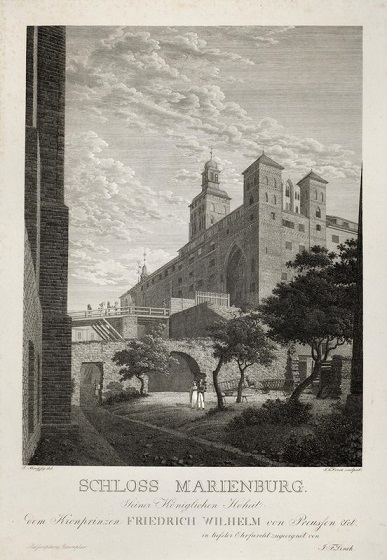Painter specializing in landscape art, draftsman, creator of theatrical decorations, art theorist, writer, educator. He was born in 1766 in the Rhine town of Leutesdorf in the district of Neuwied. He died in Gdańsk in 1831; in a city where he spent the mature and creative years of his life, influencing its cultural landscape. He first studied under the theater scenery painter Peter Beckenkamp in Koblenz; then, for some time, he collaborated with a traveling theater group, creating set designs for them. From 1791 he worked at the court of Prince Friedrich Albrecht Anhalt-Bernburg in Bernburg and Ballendstedt. In 1792 he went on a study trip to Italy, where among others, he painted a view of Rome in eight parts, taken from the imperial palace on the Palatine. In 1800 in Berlin, based on these compositions, together with Carl Ludwig Kaaz and Franz Tielker, he created the first panorama of the Eternal City in Germany. In 1799, King Frederick William III of Prussia appointed him professor at the School of Fine Arts and Crafts in Magdeburg (Kunst- und Handwerkerschule). In the years 1804–1806 and after the reactivation in 1809–1831, he headed and taught at the Gdańsk School of Fine Arts and Crafts, which at that time had its seat in the Długouliczna Gate. His students included: Carl August Gersdorff (later construction manager at the Malbork Castle), Johann Baptista Breysig, August Lobegott Randt, Michael Carl Gregorovius, Christian Gottlieb Ludwig and Johann Carl Schultz. In the 1820s, he organized the first exhibitions of old and contemporary art on the Motława River. Together with Johann Daniel Hinckel, he developed a portfolio with views of Gdańsk and the surrounding area, engraved in 1805 in the workshop of Christian Haldenwang in Karlsruhe. He worked on organizing the painting, drawing and graphic gallery belonging to Jakob Kabrun, a Gdańsk merchant and collector. He was also involved in the conservation of works of art.
For many years, after the so-called “Romantic restoration” of the Teutonic Knights stronghold in Malbork, he cooperated with the Castle Reconstruction Board (Schloßbauverwaltung), in the years 1818–1821, independently and with the participation of his students from the Gdańsk school, of a number of views and drawings measuring and documenting architecture. Today we know about these works mainly from literature. According to the information provided by the art historian Rudolf Bergau in the Berlin illustrated journal Die Dioskuren. Deutsche Kunst-Zeitung. Hauptorgan der deutschen Kunstvereine ”from 1864. Breysig was the author of over 20 watercolors (quite large in size) with views of the monument on the Nogat shores. They showed the Teutonic Knights castle in various views, including: from the Nogat side, the northern outer ward, the western Podzamcze and the interior of the Great and Summer Refectory at the Middle Castle. The Gdańsk professor also made (most likely with water paints) a view of the portal of the Church of Our Lady at the High Castle, called the Golden Gate from 1417, its projections and three sections and using 54 pages (1: 1 scale) he prepared a detailed drawing documentation of its sculptural decoration . He inventoried the polychromes in the Church of the Blessed Virgin Mary in the High Castle as well as wooden benches and stalls. In addition, he made a view of a large, colored mosaic statue of the Mother of God with Child in the outer niche of the castle temple, 6 drawings with relief decorations of the portals of the Chapel of St. Anna, three redraws of the tombstones of the great masters inside and some architectural details of the Great Refectory.
In the second half of the 19th century, most of the Malbork works by the director of the School of Fine Arts in Gdańsk was in the hands of Phillipine Breysig, who was related to the artist. According to the inventory of the Middle Castle from 1894, twelve unspecified views of the Teutonic Knights stronghold belonged to the collections of the Castle Reconstruction Board and were stored in a wardrobe in the Grand Master’s Bedroom on the main floor of the Grand Masters Palace.
The collection of the National Museum in Gdańsk includes Breysig’s watercolor showing a view of Kwidzyń with the cathedral and castle complex from the south-west.
(compiled by J. Lijka)

Zdjęcie za: http://www.uni-magdeburg.de/mbl/Biografien/0377.htm

Widok Zamku Wysokiego od północnego zachodu; ryt. Johann F. Linck wg Johanna Adama Breysiga; 1. ćw. XIX w.; papier, techniki metalowe mieszane; Muzeum Zamkowe w Malborku; nr inw. MZM/R/834; fot. Lech Okoński.
